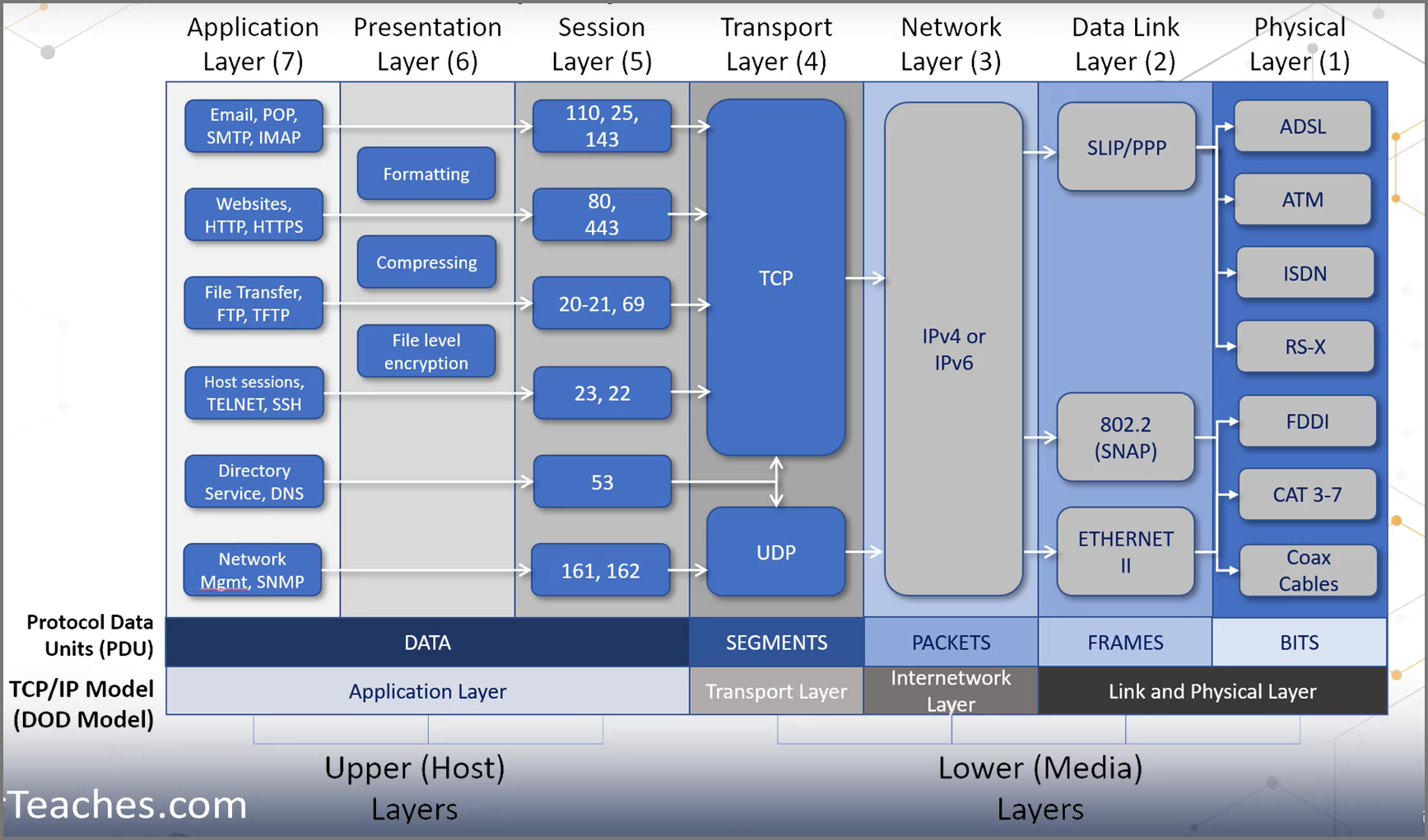Open Systems Interconnection (OSI) Model was designed in 1977 by ISO
It is reference model that shows us how data moves through a network
The networks of today use TCP-IP Model
Mnemonic
Layer Names (From Bottom): Please Do Not Throw Sausage Pizza Away
Datatype (From Top): Do Some People Fear Birthdays
| Layer | Activity Performed | |
|---|---|---|
| Data | Application | Chrome, Firefox, E-Mail Client |
| Data | Presentation | Convert to PC Understandable Format & Encryption |
| Data | Session | Maintain connection between two PC |
| Segment | Transport | Split data into packets and ordering of packets |
| Packet | Network | Decides the best Route to deliver Data |
| Frame | Data Link | Data Retransmission, Error Checking |
| Bit | Physical | Cable, Optic Fiber |
The top 3 layers also called as Host Layers are handles by the host device
The bottom 4 layers also called as Media Layers are handled by the various networking devices like routers, modems, etc.


Layer 1: Physical Layer
Defines the physical and electrical medium for communication
Converts the data received (frames) into bits (1s and 0s)
Responsible for transporting bits over the network
Physical Layer Concepts
Network Topologies
Transition Modulation
Data as 1s and 0s is transported by changing the voltage in the wire
Layer 2: Data Link Layer
Translates messages from network layer into bits for physical layer
The data at this layer is called a Frame
Responsible for checking if the data received from the physical layer is corrupted
LLC: Logical Link Control (Error Detection)
Responsible for Hop-to-Hop Communication (Devices on same network)
Packets are send to the correct device on this layer using MAC Address
Layer 3: Network Layer
Responsible for End to End Communication
Transfers (routes) data using logical addresses
Uses IP Addresses and routing algorithms to transfer packets over the network
The source and destination IP Addresses are added into the packet in this layer
IMPORTANT
Routing is sometimes also called Switching, this switching is a Layer 3 process which is different from switches which is a Layer 2 device
Layer 4: Transport Layer
Responsible for Service to Service Communication
Ports are used on this layer to send data to the right application
SSL/TLS: Layers 4 to 7
Segments (Sender) and reassembles (Receiver) data received from the higher layers
Segmented data in TCP is called Segments while data in UDP is referred as Datagram
TCP - Connection-oriented - Reliability
UDP - Connectionless - Efficiency
IMPORTANT
Data in Layer 4 is called Segments when TCP is used and its called Datagram when UDP is used
Layer 5: Session Layer
Ensures data from different application session are kept separate
Sets up, manages and tears down sessions between network devices
Setup Up Session: User credential check and unique number assignment to sessions
Manage Session: Reestablishment of connection if failure occurs and Acknowledge of receipt
Tear Down Session: End session when transfer is done or when other party disconnects
Layer 5 Protocols
H.323: Setup, maintain and tear down voice and video connections. These connection use the RTP (Real-time Protocol) for sending data
NetBIOS: Used to share files over networks
Layer 6: Presentation Layer
Ensures data from one systems can be understood by the other (Data Formatting)
Provides Character Code Conversion, Data Compression, Data Encryption
No Protocol present on this layer
Layer 7: Application Layer
At this layer the user communicates to the computer
Application here does not mean Browsers, Office, etc. rather the lower level protocols like HTTP, SSH, DNS, etc.
Service Announcement
Sending out announcements to other devices on the network to state the service they offer